-
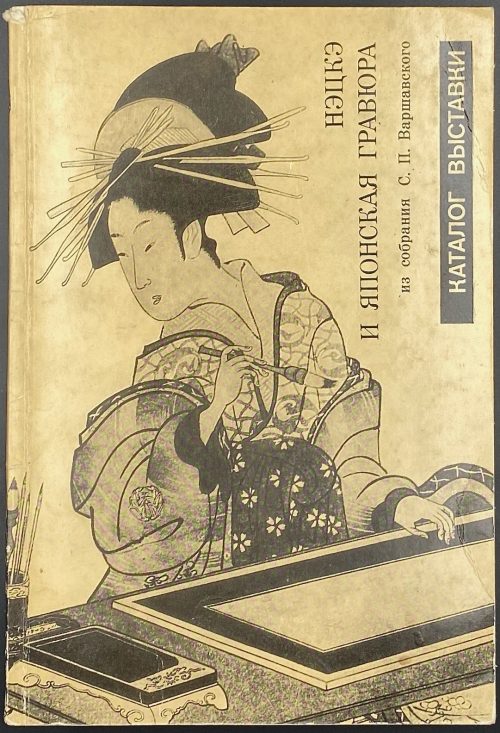 Mikhail Uspensky, Elena Varshavskaya. The netsuke and Japanese woodblock prints from the collection of S. P. Varshavsky. Printed by demand of The Hermitage Museum. Title-page (vertical bottom to top): ГОСУДАРСТВЕННЫЙ ОРДЕНА ЛЕНИНА | ЭРМИТАЖ | НЭЦКЭ | И ЯПОНСКАЯ | ГРАВЮРА | из собрания | С. П. Варшавского | КАТАЛОГ ВЫСТАВКИ | — | ЛЕНИНГРАД | “ИСКУССТВО” | ЛЕНИНГРАДСКОЕ ОТДЕЛЕНИЕ | 1983 | {vignette} || Description: Softcover, pictorial wrappers, 21.5 x 14.5 cm, pp.: [1-8] 9-42 [43-51] (b/w plates unpag.) [52] 53-76 [77-95] (b/w plates unpag.) [96] (colophon); total 96 pages plus four leaves of colour plates. Catalogue:137 entries of netsuke, 69 entries of Japanese woodblock prints. Print run: 3,000 copies. Contributors: Mikhail Uspensky [Михаил Владимирович Успенский] (Russian, 1953 – 1997) Elena Varshavsky [Елена Юрьевна Варшавская (Jewish-American, b. 1952) Vladislav Sisauri [Владислав Ираклиевич Сисаури] (Russian, b. 1944) Sergei Petrovich Varshavsky [Сергей Петрович Варшавский] (Jewish-Russian, 1906 – 1980).
Mikhail Uspensky, Elena Varshavskaya. The netsuke and Japanese woodblock prints from the collection of S. P. Varshavsky. Printed by demand of The Hermitage Museum. Title-page (vertical bottom to top): ГОСУДАРСТВЕННЫЙ ОРДЕНА ЛЕНИНА | ЭРМИТАЖ | НЭЦКЭ | И ЯПОНСКАЯ | ГРАВЮРА | из собрания | С. П. Варшавского | КАТАЛОГ ВЫСТАВКИ | — | ЛЕНИНГРАД | “ИСКУССТВО” | ЛЕНИНГРАДСКОЕ ОТДЕЛЕНИЕ | 1983 | {vignette} || Description: Softcover, pictorial wrappers, 21.5 x 14.5 cm, pp.: [1-8] 9-42 [43-51] (b/w plates unpag.) [52] 53-76 [77-95] (b/w plates unpag.) [96] (colophon); total 96 pages plus four leaves of colour plates. Catalogue:137 entries of netsuke, 69 entries of Japanese woodblock prints. Print run: 3,000 copies. Contributors: Mikhail Uspensky [Михаил Владимирович Успенский] (Russian, 1953 – 1997) Elena Varshavsky [Елена Юрьевна Варшавская (Jewish-American, b. 1952) Vladislav Sisauri [Владислав Ираклиевич Сисаури] (Russian, b. 1944) Sergei Petrovich Varshavsky [Сергей Петрович Варшавский] (Jewish-Russian, 1906 – 1980). -
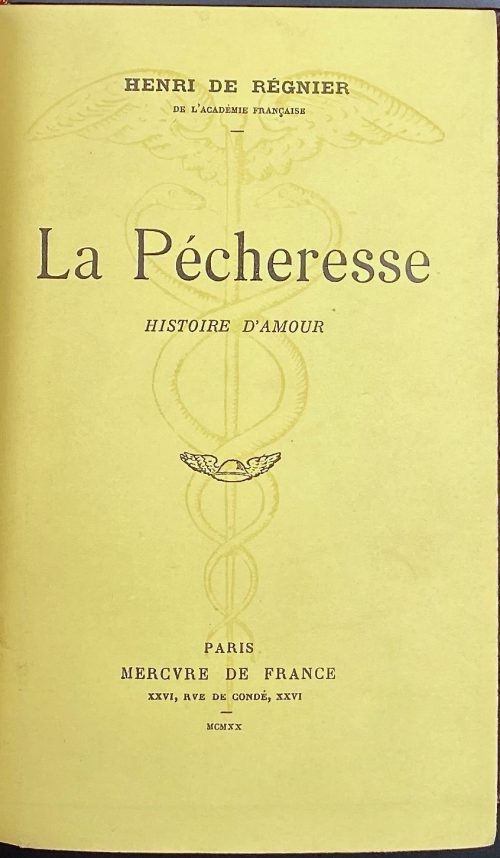 Hardcover volume, 19 x 13 cm, collated in-12mo, bound by Henri Creuzevault (signed) in full crushed brown morocco, spine with raised bands, gilt lettering “H. DE RÉGNIER | – | LA PÉCHERESSE” and “PARIS 1920” in the bottom compartment; gilt fillet to cover margin, five gilt fillets inside, marbled endpapers, bookplate of J.-P. Dutel to flyleaf, original yellow publisher’s wrappers preserved, top edge gilt, in a marbled slipcase; printed on dense wove paper (Japon). Inset: Receipt from Librairie ancienne et modern – Georges Venot (Lyon), dated April 16, 1938. Title-page / Cover: HENRI DE RÉGNIER | DE L’ACADÉMIE FRANÇAISE | – | La Pécheresse | HISTOIRE D’AMOUR | {publisher’s device} | PARIS | MERCVRE DE France | XXVI, RVE DE CONDÉ, XXVI | MCMXX || Limitation: 158 copies on Japon (№№ 1-158), 95 copies on Chine (№№ 159-253), 515 copies on Hollande (№№ 254-768), 1,650 copies on vélin pur fil de Lafuma (№№ 769-2393, and 25 copies not for sale marked A-Z. This is № 75 (on Japon), a unique copy enriched with 7 original watercolours by Serge de Solomko. Collation: 3 blank flyleaves, front wrapper, π6 (1 h.t./advert., 1 t.p./limit., 1 dedication, 3), 1-206, 212, back wrapper, spine, 3 blank flyleaves, list of illustrations pasted to recto endpaper “La Pécheresse. | 7 aquarelles de Solemko (sic.) | 57, 64, 168, 256, 289, 320, 346”, seven plates bound in as per the list. Pagination: [1-5] 6-350, ils. OCLC Number / Unique Identifier: 715077259. Contributors: Henri de Régnier (French, 1864 – 1936) – author. Auguste Gilbert de Voisins (1877 – 1939) – dedicatee. Sergueï Solomko [Сергей Сергеевич Соломко, Serge de Solomko] (Russian-French, 1867 – 1928) – artist. Henri Creuzevault (French, 1905 – 1971) – bookbinder. J.-P. Dutel description: RÉGNIER, Henri de. LA PECHERESSE. Paris, Mercure de France, 1920. In-12 (18,3 x 11,4 cm) de [1] f., 350 pp., maroquin janséniste grenat, dos à 5 nerfs, filets dorés intérieurs, tête dorée, filets dorés sur les coupes, non rogné, couverture et dos conservés, étui bordé. (Creuzevault). ÉDITION ORIGINALE. Tirage : 95 ex. sur chine. 158 ex. sur japon. 515 ex. sur hollande. UN DES 158 EXEMPLAIRES SUR JAPON. EXEMPLAIRE UNIQUE ENRICHI DE 7 AQUARELLES ORIGINALES HORS-TEXTE SIGNÉES PAR SERGE DE SOLOMKO. Sergueï Sergueïevitch Solomko « Serge de Solomko », (Saint-Petersburg, 1867- Sainte Geneviève des bois, 1928) est un illustrateur, graphiste et aquarelliste russe qui vécut en partie en France. Qualifiée d'histoire d'amour, cette œuvre d'Henri de Régnier est dédiée à Gilbert de Voisins, poète et romancier, en témoignage de fraternelle amitié. Elle est placée par son auteur sous les auspices du moraliste et critique libertin Saint-Evremond dont une citation figure en exergue du livre : « Il y a des temps où l'on pleure les plaisirs perdus, des temps où l'on pleure les péchés commis. » Et l'auteur d'incipiter comme suit : « J'ai toujours été si curieux des particularités que l'on découvre au caractère des femmes que, pas une fois, je n'ai négligé de m'instruire sur le sujet. » « (...) le point où se montre le mieux et le plus ouvertement ce que la nature les a faites, est celui de l'amour. »
Hardcover volume, 19 x 13 cm, collated in-12mo, bound by Henri Creuzevault (signed) in full crushed brown morocco, spine with raised bands, gilt lettering “H. DE RÉGNIER | – | LA PÉCHERESSE” and “PARIS 1920” in the bottom compartment; gilt fillet to cover margin, five gilt fillets inside, marbled endpapers, bookplate of J.-P. Dutel to flyleaf, original yellow publisher’s wrappers preserved, top edge gilt, in a marbled slipcase; printed on dense wove paper (Japon). Inset: Receipt from Librairie ancienne et modern – Georges Venot (Lyon), dated April 16, 1938. Title-page / Cover: HENRI DE RÉGNIER | DE L’ACADÉMIE FRANÇAISE | – | La Pécheresse | HISTOIRE D’AMOUR | {publisher’s device} | PARIS | MERCVRE DE France | XXVI, RVE DE CONDÉ, XXVI | MCMXX || Limitation: 158 copies on Japon (№№ 1-158), 95 copies on Chine (№№ 159-253), 515 copies on Hollande (№№ 254-768), 1,650 copies on vélin pur fil de Lafuma (№№ 769-2393, and 25 copies not for sale marked A-Z. This is № 75 (on Japon), a unique copy enriched with 7 original watercolours by Serge de Solomko. Collation: 3 blank flyleaves, front wrapper, π6 (1 h.t./advert., 1 t.p./limit., 1 dedication, 3), 1-206, 212, back wrapper, spine, 3 blank flyleaves, list of illustrations pasted to recto endpaper “La Pécheresse. | 7 aquarelles de Solemko (sic.) | 57, 64, 168, 256, 289, 320, 346”, seven plates bound in as per the list. Pagination: [1-5] 6-350, ils. OCLC Number / Unique Identifier: 715077259. Contributors: Henri de Régnier (French, 1864 – 1936) – author. Auguste Gilbert de Voisins (1877 – 1939) – dedicatee. Sergueï Solomko [Сергей Сергеевич Соломко, Serge de Solomko] (Russian-French, 1867 – 1928) – artist. Henri Creuzevault (French, 1905 – 1971) – bookbinder. J.-P. Dutel description: RÉGNIER, Henri de. LA PECHERESSE. Paris, Mercure de France, 1920. In-12 (18,3 x 11,4 cm) de [1] f., 350 pp., maroquin janséniste grenat, dos à 5 nerfs, filets dorés intérieurs, tête dorée, filets dorés sur les coupes, non rogné, couverture et dos conservés, étui bordé. (Creuzevault). ÉDITION ORIGINALE. Tirage : 95 ex. sur chine. 158 ex. sur japon. 515 ex. sur hollande. UN DES 158 EXEMPLAIRES SUR JAPON. EXEMPLAIRE UNIQUE ENRICHI DE 7 AQUARELLES ORIGINALES HORS-TEXTE SIGNÉES PAR SERGE DE SOLOMKO. Sergueï Sergueïevitch Solomko « Serge de Solomko », (Saint-Petersburg, 1867- Sainte Geneviève des bois, 1928) est un illustrateur, graphiste et aquarelliste russe qui vécut en partie en France. Qualifiée d'histoire d'amour, cette œuvre d'Henri de Régnier est dédiée à Gilbert de Voisins, poète et romancier, en témoignage de fraternelle amitié. Elle est placée par son auteur sous les auspices du moraliste et critique libertin Saint-Evremond dont une citation figure en exergue du livre : « Il y a des temps où l'on pleure les plaisirs perdus, des temps où l'on pleure les péchés commis. » Et l'auteur d'incipiter comme suit : « J'ai toujours été si curieux des particularités que l'on découvre au caractère des femmes que, pas une fois, je n'ai négligé de m'instruire sur le sujet. » « (...) le point où se montre le mieux et le plus ouvertement ce que la nature les a faites, est celui de l'amour. » -
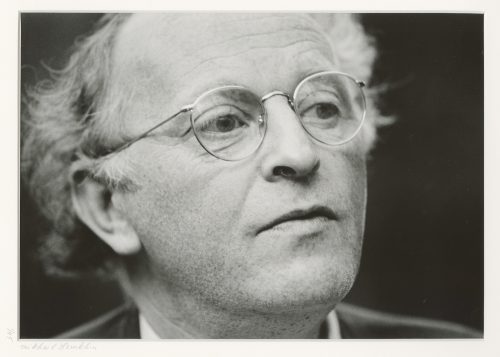 Photographic portrait of poet Joseph Brodsky, head and shoulders, three-quarters to the right, wearing glasses. Pencil-signed on the mat: 1/45 • Mikhail Lemkhin; same inscription on the back of the print, and ink stamp ©Mikhail Lemkhin. Sitter: Joseph Brodsky [Иосиф Александрович Бродский ] (Russian-American-Jewish, 1940 – 1996). Size: mat: 40.5 x 51 cm; window: 24.5 x 35 cm; print: 27.7 x 35.4 cm.
Photographic portrait of poet Joseph Brodsky, head and shoulders, three-quarters to the right, wearing glasses. Pencil-signed on the mat: 1/45 • Mikhail Lemkhin; same inscription on the back of the print, and ink stamp ©Mikhail Lemkhin. Sitter: Joseph Brodsky [Иосиф Александрович Бродский ] (Russian-American-Jewish, 1940 – 1996). Size: mat: 40.5 x 51 cm; window: 24.5 x 35 cm; print: 27.7 x 35.4 cm. -
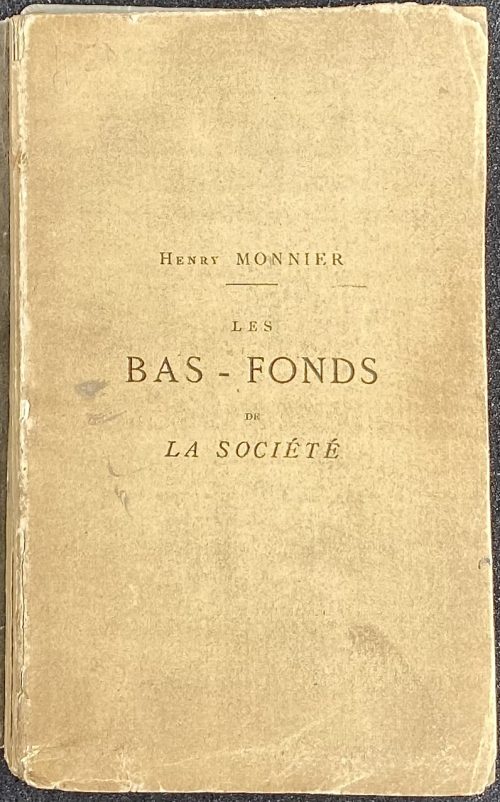 Small softcover volume, ‘édition minuscule’ in-32, 13 x 8 cm, publisher’s wrappers, pp.: [1-6] (h.t., t.p., advert.), [7] 8-160 [2 table/blank], included in pagination 8 pasted etchings on India paper after Félicien Rops and one blank leaf next to plate 1; laid paper with watermarks, some pages uncut. Title-page: DOCUMENTS | POUR SERVIR A L’HISTOIRE DE NOS MŒURS | – | LES | BAS-FONDS | DE LA SOCIÉTÉ | PAR | HENRY MONNIER | AVEC | 8 dessins à la plume | de F. R. | {fleuron} | ÉDITION MINUSCULE | tirée | à 64 exemplaires. || Pencil handwriting on top: 8 gravures de Felicien Rops | 250 –, in the bottom: [1879]. Print run: 64 copies; clandestine edition. Catalogue raisonné: Vicaire V, 1019; Bory p. 100 (though here is the frontispiece for Les Bas-fonds de la société par Joseph Prudhomme [Henry Monnier], 1864, with all the sheets together; Dutel I, A-134. Ref: (1) Poulet-Malassis & ses amis № 90 [LIB-3118.2022] ; (2) Félicien Rops: L'oeuvre graphique complète. / Ouvrage établi et présenté par Jean-François Bory. Avec un texte contemporain de l'artiste par J. K. Huysmans. — Arthur Hubschmidt, 1977. [LIB-2241.2019] Contributors: Henry Monnier (French, 1799 – 1877) – author. Félicien Rops (Belgian, 1833 – 1898) – artist. Henry Kistemaeckers (Belgian, 1851 – 1934) – publisher. Auguste Poulet-Malassis (French, 1825 – 1878)
Small softcover volume, ‘édition minuscule’ in-32, 13 x 8 cm, publisher’s wrappers, pp.: [1-6] (h.t., t.p., advert.), [7] 8-160 [2 table/blank], included in pagination 8 pasted etchings on India paper after Félicien Rops and one blank leaf next to plate 1; laid paper with watermarks, some pages uncut. Title-page: DOCUMENTS | POUR SERVIR A L’HISTOIRE DE NOS MŒURS | – | LES | BAS-FONDS | DE LA SOCIÉTÉ | PAR | HENRY MONNIER | AVEC | 8 dessins à la plume | de F. R. | {fleuron} | ÉDITION MINUSCULE | tirée | à 64 exemplaires. || Pencil handwriting on top: 8 gravures de Felicien Rops | 250 –, in the bottom: [1879]. Print run: 64 copies; clandestine edition. Catalogue raisonné: Vicaire V, 1019; Bory p. 100 (though here is the frontispiece for Les Bas-fonds de la société par Joseph Prudhomme [Henry Monnier], 1864, with all the sheets together; Dutel I, A-134. Ref: (1) Poulet-Malassis & ses amis № 90 [LIB-3118.2022] ; (2) Félicien Rops: L'oeuvre graphique complète. / Ouvrage établi et présenté par Jean-François Bory. Avec un texte contemporain de l'artiste par J. K. Huysmans. — Arthur Hubschmidt, 1977. [LIB-2241.2019] Contributors: Henry Monnier (French, 1799 – 1877) – author. Félicien Rops (Belgian, 1833 – 1898) – artist. Henry Kistemaeckers (Belgian, 1851 – 1934) – publisher. Auguste Poulet-Malassis (French, 1825 – 1878) -
 Artist: Utagawa Kuniyoshi [歌川 國芳] (1798 – 1861). Kabuki actors Ichikawa Danjūrō VIII and Arashi Rikan III as sumo wrestlers Nuregami Chōgorō (L) and Hanaregoma Chōkichi (R), respectively. Signed: Ichiyûsai Kuniyoshi ga (一勇斎 國芳 画) in a double gourd-shaped cartouche with Yoshi Kiri seal. Publisher: No seal. Date seal and double nanushi censor seal: Mera & Watanabe, 1852. Media: Fan print (uchiwa-e, 団扇絵), 231 x 295 mm. Theme: Nine-act drama (11 scenes) Futatsu Chōchō Kuruwa Nikki [双蝶々曲輪日記] (A Diary of Two Butterflies in the Pleasure Quarters) written by Takeda Izumo II, Namiki Senryū I, Miyoshi Shōraku (7/1749) as puppet play Bunraku [文楽], adopted for Kabuki theatre by Arashi San'emon IV. “The sumo wrestler Nuregami Chōgorō is trying to ransom the courtesan Azuma for Yogoro, in whose debt he stands. Hiraoka Goemon, who is at odds with Yogorō and Azuma, is the patron of the amateur wrestler Hanaregoma Chōkichi. Chōgorō purposely loses to Chōkichi and then asks the latter to stop Goemon's ransoming of Azuma; Chōkichi refuses, however, and they quarrel. Admonished for his dissipation by his sister Oseki, Chōkichi is going to commit ritual suicide (seppuku) as an apology for his behavior, but Chōgorō, who happens along just then, prevents him. The two men swear blood brotherhood. […] The confrontation between Chōgorō and Chōkichi in the Sumōba scene, acted in the exaggerated style called aragoto, is a major highlight of the work. The scene in Yohei's home, known as Hikimado, presents the unfolding of Kabuki's eternal conflict between duty and feelings, here represented by the act of opening the skylight (hikimado) to which Chōgorō is tied”. [Samuel L. Leiter. Kabuki Encyclopedia: an English-language adaptation of Kabuki Jiten. — Westport, CT; London: Greenwood Press, 1979, pp. 70-71]. See also James R. Brandon and Samuel L. Leiter. Kabuki plays on stage, vol. 1, pp. 234-258. — Honolulu: University of Hawai'i Press, 2002. Actors: Ichikawa Danjūrō VIII [市川団十郎] (Japanese, 1823 – 1854); other names: Ichikawa Ebizō VI, Ichikawa Shinnosuke II. Arashi Rikan III [嵐璃寛] (Japanese, 1812 – 1863); other names Arashi Tokusaburō III, Arashi Kicchō I, Onoe Wasaburō I. Another print in this collection with the same theme: SVJP-0331.2020.
Artist: Utagawa Kuniyoshi [歌川 國芳] (1798 – 1861). Kabuki actors Ichikawa Danjūrō VIII and Arashi Rikan III as sumo wrestlers Nuregami Chōgorō (L) and Hanaregoma Chōkichi (R), respectively. Signed: Ichiyûsai Kuniyoshi ga (一勇斎 國芳 画) in a double gourd-shaped cartouche with Yoshi Kiri seal. Publisher: No seal. Date seal and double nanushi censor seal: Mera & Watanabe, 1852. Media: Fan print (uchiwa-e, 団扇絵), 231 x 295 mm. Theme: Nine-act drama (11 scenes) Futatsu Chōchō Kuruwa Nikki [双蝶々曲輪日記] (A Diary of Two Butterflies in the Pleasure Quarters) written by Takeda Izumo II, Namiki Senryū I, Miyoshi Shōraku (7/1749) as puppet play Bunraku [文楽], adopted for Kabuki theatre by Arashi San'emon IV. “The sumo wrestler Nuregami Chōgorō is trying to ransom the courtesan Azuma for Yogoro, in whose debt he stands. Hiraoka Goemon, who is at odds with Yogorō and Azuma, is the patron of the amateur wrestler Hanaregoma Chōkichi. Chōgorō purposely loses to Chōkichi and then asks the latter to stop Goemon's ransoming of Azuma; Chōkichi refuses, however, and they quarrel. Admonished for his dissipation by his sister Oseki, Chōkichi is going to commit ritual suicide (seppuku) as an apology for his behavior, but Chōgorō, who happens along just then, prevents him. The two men swear blood brotherhood. […] The confrontation between Chōgorō and Chōkichi in the Sumōba scene, acted in the exaggerated style called aragoto, is a major highlight of the work. The scene in Yohei's home, known as Hikimado, presents the unfolding of Kabuki's eternal conflict between duty and feelings, here represented by the act of opening the skylight (hikimado) to which Chōgorō is tied”. [Samuel L. Leiter. Kabuki Encyclopedia: an English-language adaptation of Kabuki Jiten. — Westport, CT; London: Greenwood Press, 1979, pp. 70-71]. See also James R. Brandon and Samuel L. Leiter. Kabuki plays on stage, vol. 1, pp. 234-258. — Honolulu: University of Hawai'i Press, 2002. Actors: Ichikawa Danjūrō VIII [市川団十郎] (Japanese, 1823 – 1854); other names: Ichikawa Ebizō VI, Ichikawa Shinnosuke II. Arashi Rikan III [嵐璃寛] (Japanese, 1812 – 1863); other names Arashi Tokusaburō III, Arashi Kicchō I, Onoe Wasaburō I. Another print in this collection with the same theme: SVJP-0331.2020. Reference images:
Reference images:
-
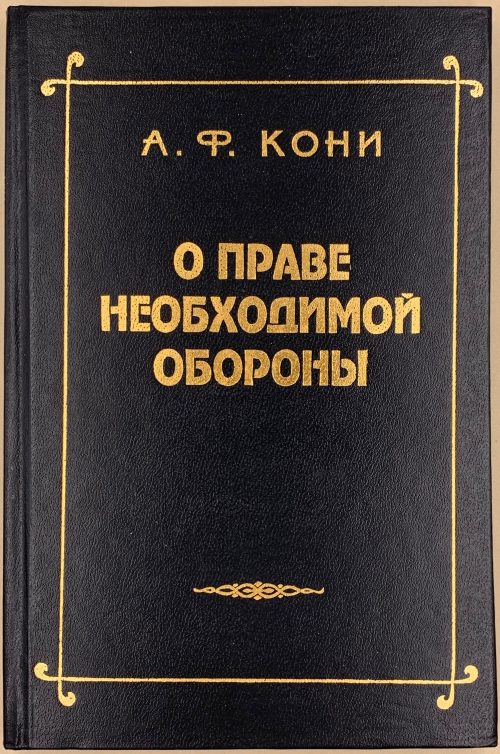 Hardcover volume, 20.8 x 13.8 cm, bound in black buckram with gilt lettering to front cover and spine; pp.: [2] 3-112. Portrait of young Anatoly Koni to fep verso. Print run: 5,000 copies. About the right of the defence of necessity – a reprint of the first work of distinguished Russian jurist Anatoly Koni, originally published in «Приложение к Университетским известиям» in 1865 and Кони А. О правѣ необходимой обороны. Рассужденiе. - М.: В Университетской Типографiи, 1866.
Hardcover volume, 20.8 x 13.8 cm, bound in black buckram with gilt lettering to front cover and spine; pp.: [2] 3-112. Portrait of young Anatoly Koni to fep verso. Print run: 5,000 copies. About the right of the defence of necessity – a reprint of the first work of distinguished Russian jurist Anatoly Koni, originally published in «Приложение к Университетским известиям» in 1865 and Кони А. О правѣ необходимой обороны. Рассужденiе. - М.: В Университетской Типографiи, 1866. -
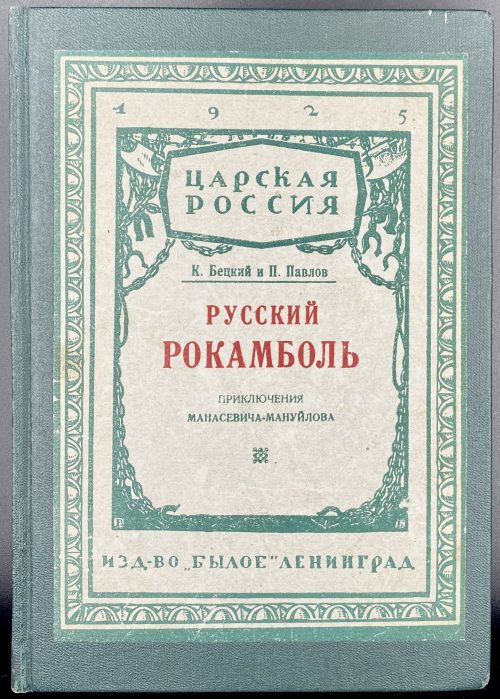 Hardcover, 20 x 14 cm, owner’s later green buckram with the original wrapper pasted to front board: wood engraving printed in green (egg and dart border with “1925” on top and “ИЗД-ВО «БЫЛОЕ» ЛЕНИНГРАД” in the bottom, inside the border a pictorial frame, depicting chains, manacles, and axes with red and green lettering inside: “ЦАРСКАЯ РОССИЯ (framed) | РУССКИЙ | РОКАМБОЛЬ | ПРИКЛЮЧЕНИЯ | МАНАСЕВИЧА-МАНУЙЛОВА | {fleuron}”; in the bottom corners of the frame monogrammed letters “В” and “Б”, for Вениамин Белкин (Veniamin Belkin). Pagination: [1-4] 5-239 [240]; collated 8vo: [1]-158, total 120 leaves. Title-page: — | К. Бецкий и П. Павлов | РУССКИЙ РОКАМБОЛЬ | (ПРИКЛЮЧЕНИЯ И. Ф. МАНАСЕВИЧА-МАНУЙЛОВА) | — | ИЗДАТЕЛЬСТВО «БЫЛОЕ» | ЛЕНИНГРАД • 1925 || Print run: 5,000 copies. Contributors: Вениамин Павлович Белкин [Veniamin Belkin] (Russian, 1884 – 1951) – artist of the cover. К. Бецкий (pseudonym), real name Иосиф Яковлевич Кобецкий (Jewish-Russian, ? – ?) – author. П. Павлов (pseudonym), real name Павел Елисеевич Щеголев (Russian, 1877 – 1931) – author. Иван Фёдорович Манасевич-Мануйлов [Исаак Тодресович Манасевич, Ivan Manassievitch-Manouïlov] (Jewish-Russian, 1869/71—1918) – character.
Hardcover, 20 x 14 cm, owner’s later green buckram with the original wrapper pasted to front board: wood engraving printed in green (egg and dart border with “1925” on top and “ИЗД-ВО «БЫЛОЕ» ЛЕНИНГРАД” in the bottom, inside the border a pictorial frame, depicting chains, manacles, and axes with red and green lettering inside: “ЦАРСКАЯ РОССИЯ (framed) | РУССКИЙ | РОКАМБОЛЬ | ПРИКЛЮЧЕНИЯ | МАНАСЕВИЧА-МАНУЙЛОВА | {fleuron}”; in the bottom corners of the frame monogrammed letters “В” and “Б”, for Вениамин Белкин (Veniamin Belkin). Pagination: [1-4] 5-239 [240]; collated 8vo: [1]-158, total 120 leaves. Title-page: — | К. Бецкий и П. Павлов | РУССКИЙ РОКАМБОЛЬ | (ПРИКЛЮЧЕНИЯ И. Ф. МАНАСЕВИЧА-МАНУЙЛОВА) | — | ИЗДАТЕЛЬСТВО «БЫЛОЕ» | ЛЕНИНГРАД • 1925 || Print run: 5,000 copies. Contributors: Вениамин Павлович Белкин [Veniamin Belkin] (Russian, 1884 – 1951) – artist of the cover. К. Бецкий (pseudonym), real name Иосиф Яковлевич Кобецкий (Jewish-Russian, ? – ?) – author. П. Павлов (pseudonym), real name Павел Елисеевич Щеголев (Russian, 1877 – 1931) – author. Иван Фёдорович Манасевич-Мануйлов [Исаак Тодресович Манасевич, Ivan Manassievitch-Manouïlov] (Jewish-Russian, 1869/71—1918) – character. -
 Artist: Utagawa Kunisada [歌川 国貞], a.k.a. Utagawa Toyokuni III [三代 歌川 豊国] (Japanese, 1786 – 1865). Signed: Toyokuni ga [豊国 画] in a red toshidama cartouche Publisher: Iseya Ichiemon [伊勢屋市右衛門] (Japanese, fl. c. 1820s – c. 1860s); seal Tsuji [辻] (Marks 16-029). Media: Untrimmed fan print (uchiwa-e), 225 x 295 mm, plus 10 mm paper strip glued on top (235 mm total height). Title: Plucking Popular Songs in Those Days [時世葉歌の爪弾] (Imayo ha-uta no tsuma-biki). Date seal and aratame seal: Ansei 3 (1856). Seller's Description: Uchiwa-e; picture intended for a summer fan. Here we see a relaxed beauty wearing loose layers of kimono and playing her shamisen instrument. She appears to be in the happy mood of spring, her singing inspired by the cherry blossoms in full bloom that we see outside of her window. She enjoys leisurely plucking with the plectrum of the shamisen and singing “ha-uta” (popular) songs. The title Ha-uta [葉歌] is normally written 端歌, which indicates a certain category of popular songs accompanied by shamisen with short texts that are drawn from daily life. Here however, the title葉歌 uses phonetically the same “ha葉“, referring to the title of the book of a collection of ha-uta songs, Matsu no ha [松の], which was published in five volumes in 1703 by Shûshôken 秀松軒. It is said that this collection of songs was written and sung by the blind (who were often musicians by livelihood). Behind her, lying on the window sill, we see two ha-uta songbooks, one open and one closed. The last half of the title tsuma-biki [爪弾] translates “to pluck with fingers” instead of a plectrum, which is the usual way of playing the shamisen.
Artist: Utagawa Kunisada [歌川 国貞], a.k.a. Utagawa Toyokuni III [三代 歌川 豊国] (Japanese, 1786 – 1865). Signed: Toyokuni ga [豊国 画] in a red toshidama cartouche Publisher: Iseya Ichiemon [伊勢屋市右衛門] (Japanese, fl. c. 1820s – c. 1860s); seal Tsuji [辻] (Marks 16-029). Media: Untrimmed fan print (uchiwa-e), 225 x 295 mm, plus 10 mm paper strip glued on top (235 mm total height). Title: Plucking Popular Songs in Those Days [時世葉歌の爪弾] (Imayo ha-uta no tsuma-biki). Date seal and aratame seal: Ansei 3 (1856). Seller's Description: Uchiwa-e; picture intended for a summer fan. Here we see a relaxed beauty wearing loose layers of kimono and playing her shamisen instrument. She appears to be in the happy mood of spring, her singing inspired by the cherry blossoms in full bloom that we see outside of her window. She enjoys leisurely plucking with the plectrum of the shamisen and singing “ha-uta” (popular) songs. The title Ha-uta [葉歌] is normally written 端歌, which indicates a certain category of popular songs accompanied by shamisen with short texts that are drawn from daily life. Here however, the title葉歌 uses phonetically the same “ha葉“, referring to the title of the book of a collection of ha-uta songs, Matsu no ha [松の], which was published in five volumes in 1703 by Shûshôken 秀松軒. It is said that this collection of songs was written and sung by the blind (who were often musicians by livelihood). Behind her, lying on the window sill, we see two ha-uta songbooks, one open and one closed. The last half of the title tsuma-biki [爪弾] translates “to pluck with fingers” instead of a plectrum, which is the usual way of playing the shamisen. -
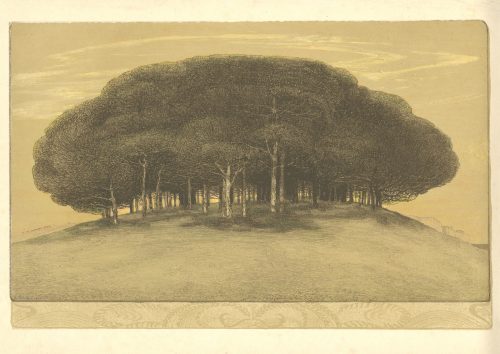 Colour (tone) lithography, image 268 x 410 mm, sheet 317 x 470 mm; signed on bottom-left of the image “Pelikan 1905”, and pencil ms inscription: E. Pelikan to the lower-right corner of the sheet. Contributor: Emilie Mediz-Pelikan (Austrian, 1861 – 1908) – artist. Seller's description: Austrian-German painter and graphic artist. Emilie Mediz-Pelikan was born in Vöcklabruck in 1861. She studied at the Vienna Academy and followed her teacher Albert Zimmermann to Salzburg and in 1885 to Munich. In 1891 she married the painter and graphic artist Karl Mediz (1868 - 1945), with whom she lived in Vienna and from 1894 in Dresden. She was in contact with the Dachau Artists' Colony and went on study trips to Paris, Belgium, Hungary and Italy. In the Dachau artists' colony she was friends with Adolf Hölzel and Fritz von Uhde. In 1889 and 1890 she spent time in Paris and in the Belgian artists' colony Knokke. In 1898 she was represented at the first art exhibition of the Vienna Secession, and in 1901 at the International Art Exhibition in Dresden. In 1903 she and her husband had a group exhibition, at the Hagenbund in Vienna. In 1904, she showed graphic works at the Dresden royal court art dealer Richter, and in 1905 and 1906 she exhibited at the Berlin Künstlerhaus. It was not until around 1900 that she achieved her artistic breakthrough with her landscape paintings. Since the estate of the artist, who died prematurely in Dresden in 1908, was lost in the former GDR until the 1980s, it was quite late that the artist was rediscovered and revalued both in Austrian art history and on the art market. In 1986, the first major exhibitions took place at the Upper Austrian State Museum and the University of Applied Arts in Vienna, followed by numerous smaller exhibitions in private galleries in Vienna, Linz and Munich. The artist received recognition during her lifetime from numerous prominent fellow painters as well as from the art critic Ludwig Hevesi. Together with Tina Blau, Herbert Boeckl, Marie Egner, Theodor von Hörmann, Franz Jaschke, Eugen Jettel, Ludwig Heinrich Jungnickel, Rudolf Junk, Gustav Klimt, Oskar Kokoschka, Johann Victor Krämer, Heinrich Kühn, Carl Moll, Rudolf Quittner, Rudolf Ribarz, Emil Jakob Schindler, Max Suppantschitsch, Max Weiler, Olga Wisinger-Florian and Alfred Zoff, she was a protagonist of the reception of Impressionism in Austria. This style went down in Austrian art history under the term "Stimmungsimpressionismus".
Colour (tone) lithography, image 268 x 410 mm, sheet 317 x 470 mm; signed on bottom-left of the image “Pelikan 1905”, and pencil ms inscription: E. Pelikan to the lower-right corner of the sheet. Contributor: Emilie Mediz-Pelikan (Austrian, 1861 – 1908) – artist. Seller's description: Austrian-German painter and graphic artist. Emilie Mediz-Pelikan was born in Vöcklabruck in 1861. She studied at the Vienna Academy and followed her teacher Albert Zimmermann to Salzburg and in 1885 to Munich. In 1891 she married the painter and graphic artist Karl Mediz (1868 - 1945), with whom she lived in Vienna and from 1894 in Dresden. She was in contact with the Dachau Artists' Colony and went on study trips to Paris, Belgium, Hungary and Italy. In the Dachau artists' colony she was friends with Adolf Hölzel and Fritz von Uhde. In 1889 and 1890 she spent time in Paris and in the Belgian artists' colony Knokke. In 1898 she was represented at the first art exhibition of the Vienna Secession, and in 1901 at the International Art Exhibition in Dresden. In 1903 she and her husband had a group exhibition, at the Hagenbund in Vienna. In 1904, she showed graphic works at the Dresden royal court art dealer Richter, and in 1905 and 1906 she exhibited at the Berlin Künstlerhaus. It was not until around 1900 that she achieved her artistic breakthrough with her landscape paintings. Since the estate of the artist, who died prematurely in Dresden in 1908, was lost in the former GDR until the 1980s, it was quite late that the artist was rediscovered and revalued both in Austrian art history and on the art market. In 1986, the first major exhibitions took place at the Upper Austrian State Museum and the University of Applied Arts in Vienna, followed by numerous smaller exhibitions in private galleries in Vienna, Linz and Munich. The artist received recognition during her lifetime from numerous prominent fellow painters as well as from the art critic Ludwig Hevesi. Together with Tina Blau, Herbert Boeckl, Marie Egner, Theodor von Hörmann, Franz Jaschke, Eugen Jettel, Ludwig Heinrich Jungnickel, Rudolf Junk, Gustav Klimt, Oskar Kokoschka, Johann Victor Krämer, Heinrich Kühn, Carl Moll, Rudolf Quittner, Rudolf Ribarz, Emil Jakob Schindler, Max Suppantschitsch, Max Weiler, Olga Wisinger-Florian and Alfred Zoff, she was a protagonist of the reception of Impressionism in Austria. This style went down in Austrian art history under the term "Stimmungsimpressionismus". -
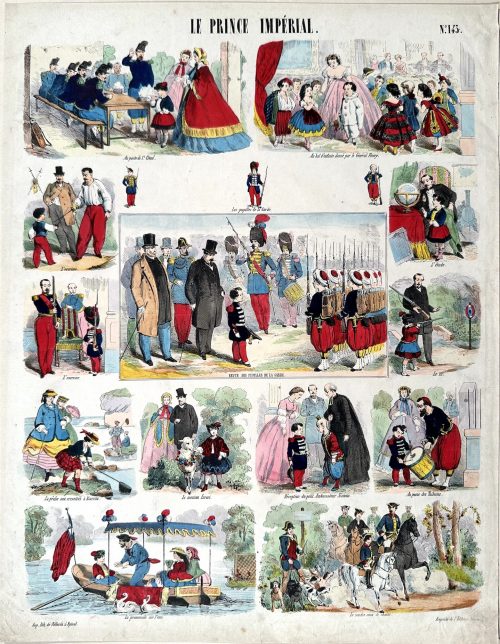 Hand-coloured woodcut on wove paper, 472 x 365 mm; black ink stamp “5275” to reverse. Top centre: "LE PRINCE IMPÉRIAL"; right: "№143." Image in the middle: Prince Impérial, with his father, conducts a review of the children's army "REVUE DES PUPILLES DE LA GARDE". Besides – five tiers of captioned cartoons. Bottom left: "Imp. lith. de Pellerin à Épinal"; right: Propriété de l’Éditeur. Déposé." Jean Charles Pellerin (French, 1756 – 1836) – printer/publisher.
Hand-coloured woodcut on wove paper, 472 x 365 mm; black ink stamp “5275” to reverse. Top centre: "LE PRINCE IMPÉRIAL"; right: "№143." Image in the middle: Prince Impérial, with his father, conducts a review of the children's army "REVUE DES PUPILLES DE LA GARDE". Besides – five tiers of captioned cartoons. Bottom left: "Imp. lith. de Pellerin à Épinal"; right: Propriété de l’Éditeur. Déposé." Jean Charles Pellerin (French, 1756 – 1836) – printer/publisher. -
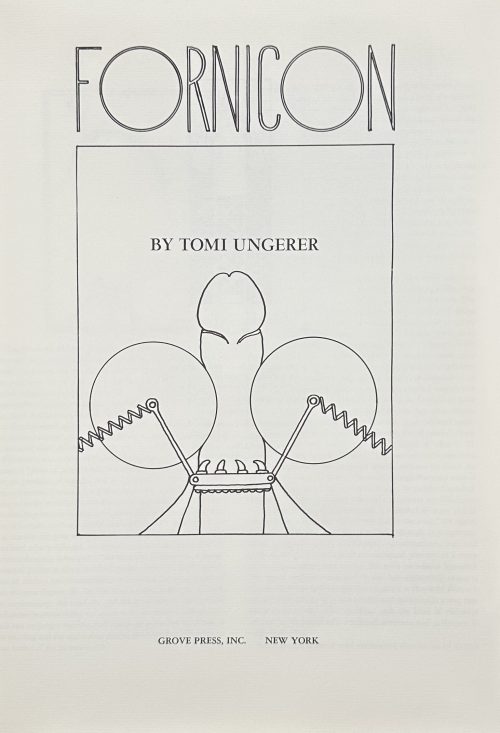 Hardcover, 333 x 247 mm, black cloth with gilt facsimile to front board and gilt lettering to spine, aubergine dust jacket with white lettering and red facsimile over black panel to front and back, crimson endpapers, laid paper, unpaginated; pp.: [4] h.t./blank, t.p./imprint, [2] text by John Hollander, 61 leaves of plates; originally published in 1969 by Rhinoceros Press, New York, as a limited-edition portfolio with slipcase. Title-page: Fornicon | (in frame) BY TOMI UNGERER | GROVE PRESS NEW YORK || Jean-Thomas [Tomi] Ungerer (French,1931 – 2019) John Hollander (American, 1929 – 2013)
Hardcover, 333 x 247 mm, black cloth with gilt facsimile to front board and gilt lettering to spine, aubergine dust jacket with white lettering and red facsimile over black panel to front and back, crimson endpapers, laid paper, unpaginated; pp.: [4] h.t./blank, t.p./imprint, [2] text by John Hollander, 61 leaves of plates; originally published in 1969 by Rhinoceros Press, New York, as a limited-edition portfolio with slipcase. Title-page: Fornicon | (in frame) BY TOMI UNGERER | GROVE PRESS NEW YORK || Jean-Thomas [Tomi] Ungerer (French,1931 – 2019) John Hollander (American, 1929 – 2013) -
 Iron tsuba of round form with design of two paper lanterns in openwork (small cut-outs, ko-sukashi ) outlined with brass wire. The plate is decorated with four concentric rows of brass dot inlay (ten-zōgan), with a brass circular wire inside the innermost row of dots (missing on the back). Hitsu-ana of rectangular form is not outlined with brass wire, which let us suppose that it was cut out at a later date. Copper sekigane. Mid Muromachi period (1454-1513). Diameter: 74.0 mm, thickness: 2.6 mm. Tsuba is illustrated at: 新版 日本刀講座 小道具鑑定編 本間 薫山 佐藤 寒山 : Shinhan Nihonto Koza, Volume VI, Kodogu Part 1. Under supervision of Honma Kunzan and Sato Kanzan. 鍔 無名 応仁 鉄地) 丸形 小透 槌目 真鍮据文 点象嵌 丸耳 : Tsuba with no signature, Ōnin style. Base metal iron (jigane), round shape, small perforations (ko-sukashi), hammering finish (tsuchime). Pre-cast brass inlay (shinchu suemon-zōgan); dot inlay (ten-zōgan); round edge (maru-mimi).
Iron tsuba of round form with design of two paper lanterns in openwork (small cut-outs, ko-sukashi ) outlined with brass wire. The plate is decorated with four concentric rows of brass dot inlay (ten-zōgan), with a brass circular wire inside the innermost row of dots (missing on the back). Hitsu-ana of rectangular form is not outlined with brass wire, which let us suppose that it was cut out at a later date. Copper sekigane. Mid Muromachi period (1454-1513). Diameter: 74.0 mm, thickness: 2.6 mm. Tsuba is illustrated at: 新版 日本刀講座 小道具鑑定編 本間 薫山 佐藤 寒山 : Shinhan Nihonto Koza, Volume VI, Kodogu Part 1. Under supervision of Honma Kunzan and Sato Kanzan. 鍔 無名 応仁 鉄地) 丸形 小透 槌目 真鍮据文 点象嵌 丸耳 : Tsuba with no signature, Ōnin style. Base metal iron (jigane), round shape, small perforations (ko-sukashi), hammering finish (tsuchime). Pre-cast brass inlay (shinchu suemon-zōgan); dot inlay (ten-zōgan); round edge (maru-mimi).
 English translation of the book indicated above Nihon Tō Kōza, Volume VI, Part 1 by Harry Afu Watson, AFU Research Enterprises, Inc., 1993. Tsuba in question illustrated on page 14 and described as follows: " Tsuba mumei Ōnin. Tetsu ji maru gata ko-sukashi tsuchime shitate shinchū suemon ten zogan maru mimi. Brass suemon". My question remains: why such a text is called 'translation' while it looks more like transliteration of romanization?
English translation of the book indicated above Nihon Tō Kōza, Volume VI, Part 1 by Harry Afu Watson, AFU Research Enterprises, Inc., 1993. Tsuba in question illustrated on page 14 and described as follows: " Tsuba mumei Ōnin. Tetsu ji maru gata ko-sukashi tsuchime shitate shinchū suemon ten zogan maru mimi. Brass suemon". My question remains: why such a text is called 'translation' while it looks more like transliteration of romanization? -
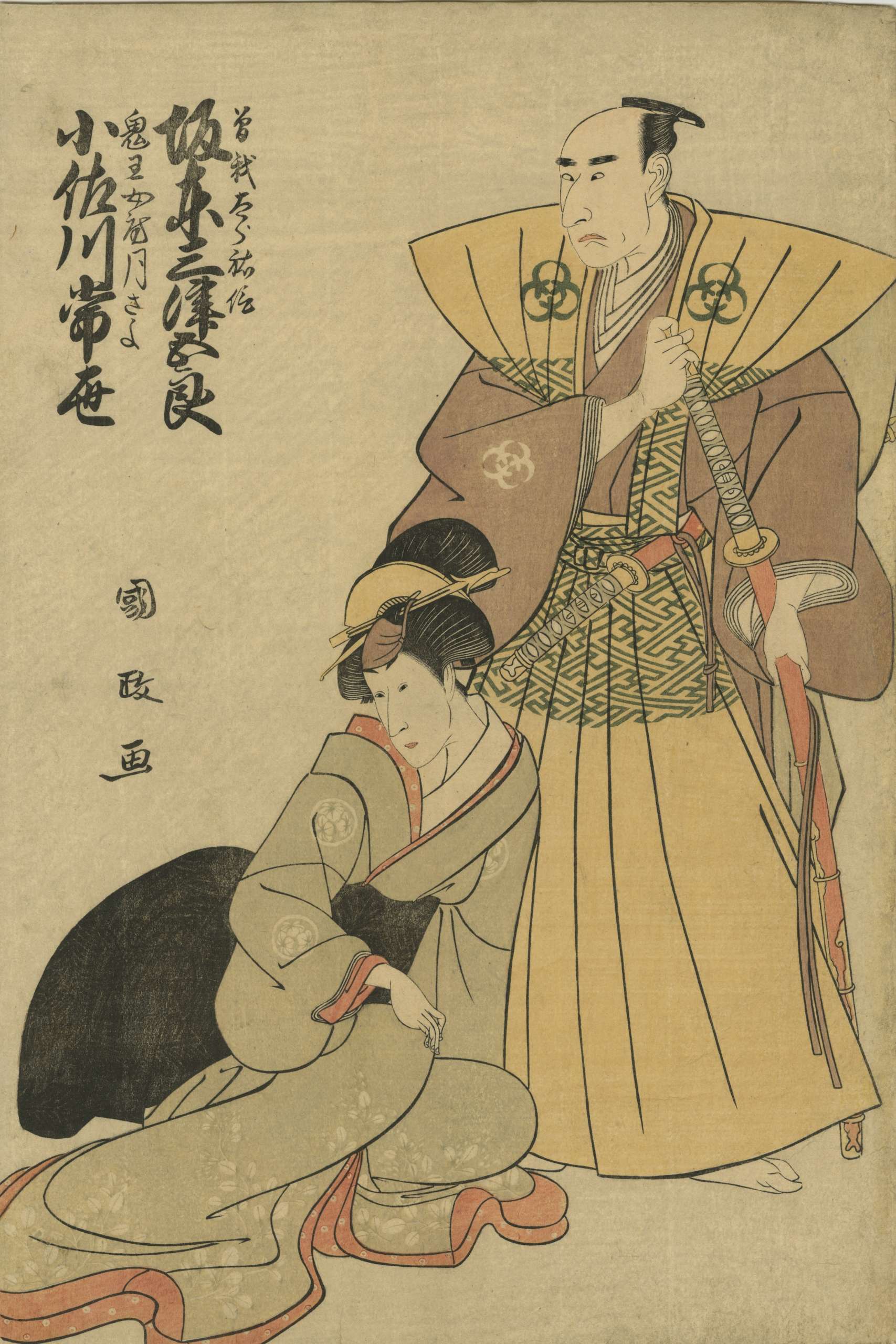 Bando Mitsugoro II as Soga no Taro Sukenobu, the step-father of the Soga brothers, and Osagawa Tsuneyo II as Onio's wife Tsukisayo, in the play 'Omonbi Kuruwa Soga' performed at the Ichimura-za in the 1st month of 1799. Reference: Harvard Art Museums accession number 1933.4.525. Publications: Narazaki Muneshige, Ukiyo-e shuka [Collection of the Masterpieces of Ukiyo-e Prints in Museums] Volume 8: Foggu Bijutsukan [Fogg Art Museum, Harvard University], Neruson Bijutsukan [Nelson Atkins Museum]..., Shogaku-kan (Tokyo, Japan, 1980 [Showa 55]), Color Plate 107; p. 104 (entry p. 191). SOLD
Bando Mitsugoro II as Soga no Taro Sukenobu, the step-father of the Soga brothers, and Osagawa Tsuneyo II as Onio's wife Tsukisayo, in the play 'Omonbi Kuruwa Soga' performed at the Ichimura-za in the 1st month of 1799. Reference: Harvard Art Museums accession number 1933.4.525. Publications: Narazaki Muneshige, Ukiyo-e shuka [Collection of the Masterpieces of Ukiyo-e Prints in Museums] Volume 8: Foggu Bijutsukan [Fogg Art Museum, Harvard University], Neruson Bijutsukan [Nelson Atkins Museum]..., Shogaku-kan (Tokyo, Japan, 1980 [Showa 55]), Color Plate 107; p. 104 (entry p. 191). SOLD -
 Utagawa Toyokuni (歌川豐國); 1769 – 24 February 1825. The actor Nakamura Utaemon as Ishikawa Goemon. Circa 1810. Size/Format: Oban, 9.75 by 14.5 inches
Utagawa Toyokuni (歌川豐國); 1769 – 24 February 1825. The actor Nakamura Utaemon as Ishikawa Goemon. Circa 1810. Size/Format: Oban, 9.75 by 14.5 inches -
 Iron tsuba of round form decorated with chrysanthemums, pine cones and needles, pampas grass, vines, cherry blossoms, and wild geese in brass inlay (suemon-zōgan) and pierced with designs of water clover (denjiso) and half bellflower (or karahana) to the left and to the right of nakago-ana as well as double bars above and below nakago-ana (possibly with the meaning of number 2 or ordinal 2nd). Most probably the sukashi elements here are the family crests (mon). Unsigned. Ōnin school. Muromachi period; 15th or 16th century. Height: 82.1 mm; Width: 80.9 mm; Thickness at seppa-dai: 2.4 mm NBTHK # 2003827: Tokubetsu Hozon Tosogu Kanteisho (特別保存刀装具鑑定書) - "Extraordinarily Worthy of Preservation".
Iron tsuba of round form decorated with chrysanthemums, pine cones and needles, pampas grass, vines, cherry blossoms, and wild geese in brass inlay (suemon-zōgan) and pierced with designs of water clover (denjiso) and half bellflower (or karahana) to the left and to the right of nakago-ana as well as double bars above and below nakago-ana (possibly with the meaning of number 2 or ordinal 2nd). Most probably the sukashi elements here are the family crests (mon). Unsigned. Ōnin school. Muromachi period; 15th or 16th century. Height: 82.1 mm; Width: 80.9 mm; Thickness at seppa-dai: 2.4 mm NBTHK # 2003827: Tokubetsu Hozon Tosogu Kanteisho (特別保存刀装具鑑定書) - "Extraordinarily Worthy of Preservation". -
 Iron tsuba of round form inlaid with brass, copper, and shakudō wire fastened to the surface with metal staples (mukade-zōgan); Scalloped brass inlay around the rim. Early Edo, 17th century. Height: 84.8 mm; Width 84.8 mm; Thickness at seppa-dai: 3.7 mm. Weight 161.6 g. Design is thought to resemble a centipede. "Centipede-like inlay (mukade zogan) of alternating iron and brass staples produce an appearance that was particularly favored by Takeda Shingen (1521-1573), one of the most powerful warlords of his time. The centipede is sacred to Bishamon (God of War) and especially propitious for a warrior. Shingen type, 16th century.” [The Peabody Museum collection of Japanese sword guards with selected pieces of sword furniture, by John D. Hamilton. Photographs by Mark Sexton. Salem, MA, 1975.] See also: http://varshavskycollection.com/shingen-tsuba/
Iron tsuba of round form inlaid with brass, copper, and shakudō wire fastened to the surface with metal staples (mukade-zōgan); Scalloped brass inlay around the rim. Early Edo, 17th century. Height: 84.8 mm; Width 84.8 mm; Thickness at seppa-dai: 3.7 mm. Weight 161.6 g. Design is thought to resemble a centipede. "Centipede-like inlay (mukade zogan) of alternating iron and brass staples produce an appearance that was particularly favored by Takeda Shingen (1521-1573), one of the most powerful warlords of his time. The centipede is sacred to Bishamon (God of War) and especially propitious for a warrior. Shingen type, 16th century.” [The Peabody Museum collection of Japanese sword guards with selected pieces of sword furniture, by John D. Hamilton. Photographs by Mark Sexton. Salem, MA, 1975.] See also: http://varshavskycollection.com/shingen-tsuba/ -
 Artist: Utagawa Toyokuni I (1769–1825) Title: Actors Bando Mitsugorō, Ichikawa Danjūrō, Onoe Kikugorō in play The Maiden at Dōjō Temple. Presumably Bunka 13 (1816) at Nakamura Theater in Edo. Publisher: Mikawaya Seiemon (c. 1805-1829); Marks' "Publishers" № 328, p. 235. Size: Vertical ôban MEDIUM OR TECHNIQUE: Woodblock print (nishiki-e); ink and color on paper. Signed: Toyokuni ga Censor's seal: kiwame Detailed discussion on the topic can be seen at: The Maiden at Dōjō Temple
Artist: Utagawa Toyokuni I (1769–1825) Title: Actors Bando Mitsugorō, Ichikawa Danjūrō, Onoe Kikugorō in play The Maiden at Dōjō Temple. Presumably Bunka 13 (1816) at Nakamura Theater in Edo. Publisher: Mikawaya Seiemon (c. 1805-1829); Marks' "Publishers" № 328, p. 235. Size: Vertical ôban MEDIUM OR TECHNIQUE: Woodblock print (nishiki-e); ink and color on paper. Signed: Toyokuni ga Censor's seal: kiwame Detailed discussion on the topic can be seen at: The Maiden at Dōjō Temple -
 An iron tsuba in the shape of a bold or shaved human head in full round. Unsigned. Dimensions: 62.5 x 53.4 x 4.4 mm Iron, in the shape of a Ni O (Nio) head, in full round, the back flat chased as a pine forest. Signed : Miōchin Masatsugu in sosho. №38 in The Naunton Collection, 1912. There are a few tsuba of such design known. SOLDIron, a severed head. Signed: Takeaki of Kwaiyō. Ex Hawkshaw Collection [Plate VII]. Below written: Takurio, Suruga, 1118; Tamagawa, p. ; Tanaka, p. 168; Tanetora, 1894. №2729 in The Naunton Collection, 1912.
An iron tsuba in the shape of a bold or shaved human head in full round. Unsigned. Dimensions: 62.5 x 53.4 x 4.4 mm Iron, in the shape of a Ni O (Nio) head, in full round, the back flat chased as a pine forest. Signed : Miōchin Masatsugu in sosho. №38 in The Naunton Collection, 1912. There are a few tsuba of such design known. SOLDIron, a severed head. Signed: Takeaki of Kwaiyō. Ex Hawkshaw Collection [Plate VII]. Below written: Takurio, Suruga, 1118; Tamagawa, p. ; Tanaka, p. 168; Tanetora, 1894. №2729 in The Naunton Collection, 1912.
№38 Naunton Collection, 1912.
Reference to Hawkshaw Collection [Plate VII] happened to be not exact; it is Plate VIII, №236. It is clearly not the Hawkshaw piece (different facial expression, signle hitsu-ana, no plug. Description at Hawkshaw, 1910, reads: Iron, in the shape of a man's head, severed at the neck, the forehead in three wrinkles, the mouth hard-set and drooping, the eyes open, inlaid brass with shakudo pupils. Signed: Shoami; dated second year of Shoho, first month [SV: December 1644 through February 1648].
№2729 Naunton Collection, 1912.

№236 Hawkshaw Collection, 1910.




